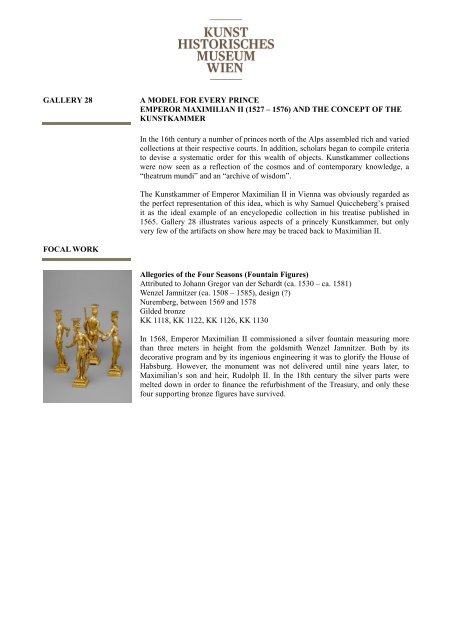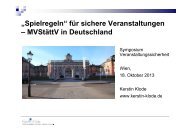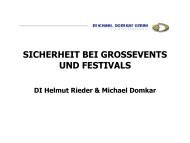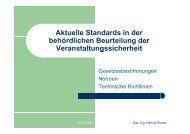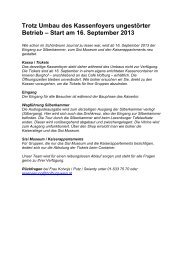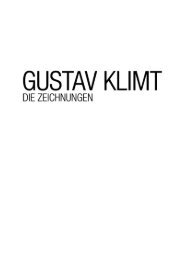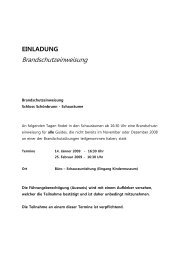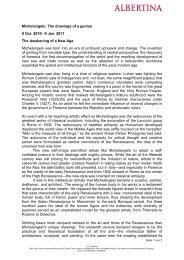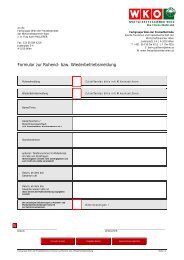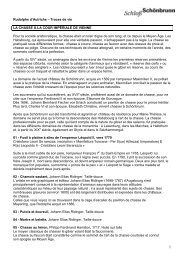kunstkammer vienna the cradle of the museum - Freizeitbetriebe ...
kunstkammer vienna the cradle of the museum - Freizeitbetriebe ...
kunstkammer vienna the cradle of the museum - Freizeitbetriebe ...
Create successful ePaper yourself
Turn your PDF publications into a flip-book with our unique Google optimized e-Paper software.
GALLERY 28 A MODEL FOR EVERY PRINCE<br />
EMPEROR MAXIMILIAN II (1527 – 1576) AND THE CONCEPT OF THE<br />
KUNSTKAMMER<br />
FOCAL WORK<br />
In <strong>the</strong> 16th century a number <strong>of</strong> princes north <strong>of</strong> <strong>the</strong> Alps assembled rich and varied<br />
collections at <strong>the</strong>ir respective courts. In addition, scholars began to compile criteria<br />
to devise a systematic order for this wealth <strong>of</strong> objects. Kunstkammer collections<br />
were now seen as a reflection <strong>of</strong> <strong>the</strong> cosmos and <strong>of</strong> contemporary knowledge, a<br />
“<strong>the</strong>atrum mundi” and an “archive <strong>of</strong> wisdom”.<br />
The Kunstkammer <strong>of</strong> Emperor Maximilian II in Vienna was obviously regarded as<br />
<strong>the</strong> perfect representation <strong>of</strong> this idea, which is why Samuel Quiccheberg’s praised<br />
it as <strong>the</strong> ideal example <strong>of</strong> an encyclopedic collection in his treatise published in<br />
1565. Gallery 28 illustrates various aspects <strong>of</strong> a princely Kunstkammer, but only<br />
very few <strong>of</strong> <strong>the</strong> artifacts on show here may be traced back to Maximilian II.<br />
Allegories <strong>of</strong> <strong>the</strong> Four Seasons (Fountain Figures)<br />
Attributed to Johann Gregor van der Schardt (ca. 1530 – ca. 1581)<br />
Wenzel Jamnitzer (ca. 1508 – 1585), design (?)<br />
Nuremberg, between 1569 and 1578<br />
Gilded bronze<br />
KK 1118, KK 1122, KK 1126, KK 1130<br />
In 1568, Emperor Maximilian II commissioned a silver fountain measuring more<br />
than three meters in height from <strong>the</strong> goldsmith Wenzel Jamnitzer. Both by its<br />
decorative program and by its ingenious engineering it was to glorify <strong>the</strong> House <strong>of</strong><br />
Habsburg. However, <strong>the</strong> monument was not delivered until nine years later, to<br />
Maximilian’s son and heir, Rudolph II. In <strong>the</strong> 18th century <strong>the</strong> silver parts were<br />
melted down in order to finance <strong>the</strong> refurbishment <strong>of</strong> <strong>the</strong> Treasury, and only <strong>the</strong>se<br />
four supporting bronze figures have survived.


